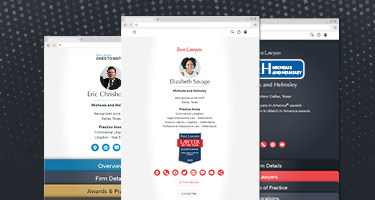In a perfect world, all those who have been harmed due to the negligence of others would receive justice. Unfortunately, that is not always the case and litigation becomes the only path to a solution.
While a financial settlement is important to help put shattered lives back together, litigation is not solely about seeking compensation for a wrong. The law is also an instrument of positive social change.
It can be reasonably argued that we have laws dealing with asbestos, smoking, seatbelts, food safety and a host of other areas, thanks to trial lawyers. Governments make laws but it is often in reaction to something that has occurred in the legal arena. The settlements lawyers negotiate or win at trial for victims who have been harmed by the wrongdoing of others often lead to changes that ultimately serve us all.
The Law Is Constantly Evolving.
Plaintiff-side lawyers are often all that stands between their clients and a future of pain and financial insecurity. However, fighting on behalf of victims of negligence can be a difficult battle.
The law is constantly evolving and not always to the benefit of plaintiffs. As well, powerful interests constantly seek to use the law to limit or deny compensation to victims. Insurance providers have proven to be powerful and effective lobbyists, resulting in legislative changes that often handcuff personal injury lawyers and their clients.
In recent years, lawyers have been met with obstacles that hamper our ability to provide justice and fair compensation for our clients. It is a sad reality that the cost of litigation is also becoming increasingly out of reach for the average plaintiff.
The pursuit of justice has become so expensive that too many people are being frozen out. There was a time that $50,000 cases were viable. However, to get to trial today, you may have to spend $30,000.
That is why a move to class action and mass tort lawsuits appears inevitable.
A Changing Legal Landscape.
The American litigation experience tends to foreshadow what we can expect to see in Canada. In the United States there has been an explosion in class action and mass tort lawsuits.
For good reason. A single claimant may not have the financial resources to pursue a lawsuit to its conclusion. However, if multiple people have been harmed due to the negligence of one or more at-fault parties, it can make more sense to file a class-action or mass tort lawsuit.
You may have a strong case. You may be entitled to substantial damages. But if you are a single litigant going up against a large entity with a vast war chest, it may not be worth the time, money and effort it takes to bring the case to trial. If you have a number of people who have the same issue, however, you could proceed as a mass tort or class action and gain the upper hand.
So, what is class action and mass tort litigation? Class actions and mass torts are basically two different ways of allowing a large group of claimants to pursue litigation against a common defendant.
Proceeding as a class action or mass tort makes sense in situations where the damages are insufficient to justify a stand-alone case or where there is a significant litigation risk. There is strength in numbers. Resources can be pooled and costs shared.
Class action and mass torts offer a vehicle that can provide access to justice for deserving victims who may otherwise never get their day in court. While highly complex, and not to be undertaken lightly, class actions and mass torts can be used effectively to help those who may be left without any other remedy.
Class action and mass tort litigation are certainly not for the faint of heart. However, if the U.S. experience is any indication, they are likely the next stage of personal injury litigation in Ontario.
Law firms considering these types of cases would be well advised do their homework and consider collaboration with like-minded colleagues who have experience in the area, such as those found here at Gluckstein Lawyers. Such creative partnership will likely be necessary in the future to ensure victims have a means to seek fair and just compensation.
What Is a Class Action?
Introduced in Ontario in 1993 with the passage of the Class Proceedings Act, class-action lawsuits are civil claims brought by one or more people on behalf of a larger group, known as class members. Rather than having each individual sue a defendant, the class can band together under a representative claimant to launch the suit.
Class actions can handle different areas of the law, such as personal injury or product liability. Some notable types and examples of class actions in Ontario are:
- Environmental accidents, such as the contamination of the Walkerton water supply.
- Institutional abuse in residential schools.
- Consumer protection matters.
- Personal injury claims arising from tainted blood products.
- Abuse of privacy with regard to credit card and data security.
- Labour and employment disputes involving pensions and gender discrimination.
- Product liability concerning medical device implants and food product recalls.
- Federal and provincial inmate treatment with respect to solitary confinement.
- Securities issues.
- Fertility clinic claims.
To proceed with a class action, it must be certified by the courts. There must be “some basis in fact” that the class members share common issues. To meet this standard, you must show how those common issues define the class and compile evidence to support the claim.
These cases tend to be won or lost at the certification level. If successful on certification, the likelihood of entering settlement negotiations significantly increases, or at a minimum, the chances of success at trial greatly improves. However, losing at the certification level means the class action will not proceed.
Settlements for class actions are typically calculated using criteria agreed to by the parties or set by the Court. Different plaintiffs can get different amounts in damage awards.
While class actions can be effective, recent Ontario government legislation has made it more difficult to certify cases and for lawyers to get their costs. Since then, many class-action cases have been filed in Quebec and British Columbia where the laws are more accommodating for plaintiffs.
What Is a Mass Tort?
Mass tort litigation in Canada is in its infancy. Mass torts originated largely in the United States and are really nothing more than a group – often a large group – of lawsuits brought separately but usually consider a similar fact situation.
In a mass tort case, every claimant commences their own lawsuit. If a class action can be seen as a battleship where everyone is in the same boat, a mass tort is like a swarm of bees, all flying in the same direction and working together, but each claim is still its own independent entity.
What has happened in the United States, and what is likely coming to Canada, is a system whereby a group of lawyers chosen to steer the actions through the courts selects a number of representative actions to take to trial. The remaining cases are then resolved using the results of the trial as guidelines.
Mass torts can range from a handful of claimants to cases involving tens of thousands. Cases can involve defective goods or dangerous products or medications, toxic exposure or catastrophic accidents. There can be a common defendant or more than one.
Earlier this year 3M agreed to pay US$6.01 billion to settle lawsuits by American military veterans and service members who say they suffered hearing loss from using the company's earplugs. It was reportedly the largest mass tort litigation in U.S. history.
Trust in Our Expertise.
In the United States, personal injury mass torts are much more common than class actions. This is largely due to well-established case law that found that class actions are inappropriate when there are differences between the plaintiffs’ situations and where damages are more individual than common.
There is every reason to believe that litigation in Canada will continue to move in the same direction as we have seen in America. Unfortunately, it is much more difficult to prosecute class actions and mass torts in this country. Every province has its own enabling legislation for class action lawsuits, and in some respects, the rules and risks set out in those statutes vary widely.
Class action or mass tort litigation can provide justice for an increasing number of claimants who are facing an unfair playing field.
















